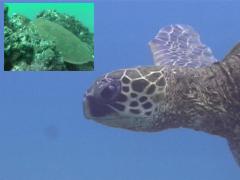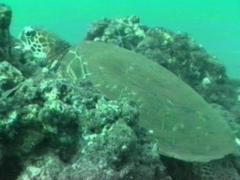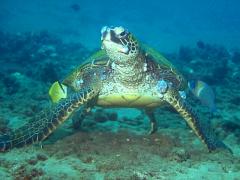Kamaha'o a/k/a Ghost [1993 Turtle 34]
|
|
That was then (inset, 1993) and this is now (2003).
30K JPEG
|
| Quickstats: Seen 1993, 1994, 1995, 1996, 1997, 1998 (60K JPEG), 1999 (56K JPEG), 2000 (58K JPEG), 2001 (53K JPEG), 2002 (56K JPEG), 2003. |
Summer updates: 1999, 2000, 2001, 2002, 2003, 2004. |
We first sighted Ghost in 1993. By then we'd already gained the trust of several Honokowai honu. These turtles would approach and land at the Turtle House while we were there. Acclimated to our presence, they let us observe and learn.
One turtle kept its distance, though. She was there regularly. She'd circle us or swim past, but made it clear we weren't welcome in her ocean. This meant we never clearly documented what she looked like.
We knew she had serious tumors. We called her "Ghost" because that's all she was--an apparition passing in the distance now and then, keeping far enough away to remain a mystery.
On one fortunate occasion, however, she was resting on a rock outcropping that provided enough cover to let us to sneak up on her. We got close enough to record her left profile. That gave us a positive identification for 1993 and future years. This is what she looked like in 1993.
In 1994, Ghost was at her worst. She did let us get better photographs and videotape, though. In this picture, you can see clearly that she was not in good condition. Particularly threatening are the mouth tumors.
We were so sure she was a goner that in subsequent years when we did our identifications, we'd only examine Ghost's profile to verify her identity, not considering seriously that she could survive past another year or two. After all, Ghost was a juvenile when we met her.
We've gone on record here, and even in a talk presented at the 17th Annual Sea Turtle Symposium in Orlando, that fibropapilloma is a complete death sentence for little turtles. As recently as October 13th, 1998, Ursula posted this on the mailing list CTURTLE:
But--(and this has worried us for a couple of years now) the disease is absolutely brutal on all youngsters--yes, all. Every single kiddy who's hung around long enough (average three years) has gotten FP. We now have upwards of 8 to 10 such examples.
While we can now confidently list 21 regression cases (and two of those recoveries are remarkable) all involve sub-adult or adult turtles--mostly males. Regression does not appear to happen with juveniles. In our experience, ALL youngsters get worse and eventually "disappear."
We were pretty sure of the thoroughness of this disease in the young. When we first read the recent paper by Balazs et al. reporting four regression cases out of his 89 Kaneohe recaptures with FP, we were astounded to read that one of those four was a juvenile!
In examining our 1998 videotapes, we noticed a turtle with a few tumors. Eyes were clear, which is a sign to us to consider the possibility we had a regression case. We recognized her as a turtle sighted in 1996 and again in 97... Tumors indeed shrinking.
Before the Balazs paper, we might not have connected this turtle with the weak, sickly juvenile from 1993. That turtle, after all, should be dead. Somehow, however, Ursula made the connection. Her notes read:
I saw Ghost's face in that turtle. (Only people who identify animals by markings will understand that...)
When we checked this turtle's markings with that of Ghost, we got a perfect match on both profiles except for one plate on the left side that was coloured darker (likely algae in the early days). So in addition, we examined left and right flipper patterns. (In our 1993 images, the flippers were actually clearer than Ghost's face!) The regression case was indeed Ghost.
George referred to his young Kaneohe regression case as "remarkable." We can't improve on that. As a juvenile that managed to recover from this devastating disease, Ghost is also remarkable. We believe that every honu has a spiritual Hawaiian name which it will reveal to you at the appropriate time. This is that time. Ghost, Turtle 1993 #34 is now Kamaha'o (KA ma HA oh).
You guessed it. That's Hawaiian for "remarkable."
Kamaha'o's Summer 99 first sighting was indeed memorable.
Many times a day we scan the ocean with binoculars. From our vantage point we can see turtles surfacing over our entire dive site. In 1998, we were surprised to see shells poking up to the north. We were baffled by this. Was this a new turtle site or one that had been established for quite a while that we hadn't noticed?
When we returned in the Summer of 1999, we scanned the ocean before our first dive and saw the north shells again. We were interested to note more
turtles surfacing at this site than the year before. It was time to find North House.
So on July 7th, we headed north instead of to the Turtle House, and--voila! We came upon a high crested coral reef and Mount Balazs, a large coral outcropping poking out of the sand bottom.
Near the outcropping, six turtles rested. Four left, and two calmly watched our approach. We were delighted to recognize one of them: Kamaha'o, now a splendid looking subadult.
Kamaha'o was a juvenile with fibropapilloma when we first met in 1993. Now, six years later, Kamaha'o is a robust close-to-maturity honu free from fibropapilloma disease--our only juvenile regression case.
We fully expect Kamaha'o's good fortune to continue into the Year 2000. In the next few years (two, perhaps three) we hope to discover this turtle's sex. The stats suggest strongly that Kamaha'o will turn out to be a male.
In 1999 we added three new regression cases to our Good News Stable. All three were male, raising the male/female regression case ratio from 8 to 3 to 11 to 3. We figure this makes the odds for Kamaha'o to be a boy turtle pretty strong.
Boy or girl, we hope to see Kamaha'o during Summer 2000.
Kamaha'o--what a wonderful turtle! To us, this honu is a living symbol of hope, the only juvenile ever to recover from fibropapilloma disease.
We sighted Kamaha'o for the first time on our July 23rd morning dive resting at Mt. Balazs--the same place we first saw her in 1999. Kamaha'o remains in good health. Only the closest of inspections would reveal this turtle ever had fibropapilloma tumours.
Boy or girl? We still don't know. Certainly other turtles who've reached Kamaha'o's size managed to sprout long tails and give us a hint. We inspected Kamaha'o's tail carefully this summer. While it has grown longer over the years, it is still not suggesting that this adolescent honu is a male.
If Kamaha'o is a female, the "results" will take even longer to come in. We count a turtle as female only if she carries tags and is a proven nester at French Frigate Shoals.
We sighted Kamaha'o often after our initial sighting. Most of the time, this honu preferred North House (especially the seaward edge of North Reef) as a place to hang out and catch some rays.
Summer 2001 proved different as far as Kamaha'o was concerned. When we saw her during a dive to North House on July 13th, we were no longer surprised to resight her; however, seeing this turtle for the first time each summer never dimishes our delight.
Anyone looking at her would see a robust honu "teenager" just on the cusp of adulthood. A few more years of growth and steering clear of danger and we will see Kamaha'o grow into a beautiful adult honu.
The main question at this point is what sex is Kamaha'o? We usually call honu "she" until a long tail tells us to do otherwise. So far, Kamaha'o hasn't got such a tail.
Kamaha'o spent most of her time at North House this summer. She rested with others and for the most part ignored us. She is now accepting of our presence and allows us to take all the photos we want. It's clear she prefers turtle-company to ours, though, and she's not one to interact or approach us.
She knows she doesn't have to fear us, but seems to prefer the quiet of non-human neighbours. We do our best to grant her that wish by merely noting her presence and then moving on to something or someone else.
This summer marked an anniversary for Kamaha'o--now a Honokowai resident for ten seasons. We can add another honu to the green sea turtles we've known for almost a decade.
We sighted Kamaha'o the afternoon of July 4th and after that, often throughout the summer.
In 1993, this turtle was a juvenile with serious fibropapilloma disease and we accepted that the little honu was doomed. Now, we can legitimately expect to know the sex of this turtle in a year or two.
Considering Kamaha'o's size, if this honu were a male the tail would already show an increase in length. A continued stubby tail suggests that Honokowai's only juvenile FP regression case just might be female!
At least, that is our hope. If it turns out Kamahao really is a female, she'll be the boldest member of that sex we've ever met. Kamaha'o is assertive with a flipper and also prepared to bulldoze us if we haven't moved out the way quickly enough.
So external appearance suggests "female," behaviour hints "male." Either way, Kamaha'o is growing into a fine young adult honu.
Kamaha'o was sighted in our first week in 2003, looking healthy and happy. We always look closely for signs of any recurrence of FP, but we're pretty confident now that Kamaha'o has beaten the disease.
There's still no sign of a lengthening tail. This doesn't resolve whether Kamaha'o is male or female, but our log notes for 2003 say:
Tail suggests likely a female.
We saw Kamaha'o often during 2003. If, as we now suspect, she's a she, then any summer now she'll go missing. She's big enough to be a nester.
We didn't see Kamaha'o in 2004. It's quite possible that she made her first nesting migration. On the other hand, a lot of regulars were not around in 2004 and this turtle could simply have moved on with the others.
If she is at Honokowai in 2005, we might be able to see the remains of a mototool engraving, which would confirm that she nested. Those markings usually fade away by the time ten months have elapsed, though, so the chances are slim that will happen--and of course, he might be a he. With our luck, Kamaha'o will be there, still with a short tail and without any engraving, thus remaining a honu of mystery. Either way, we'll be happy to see her/him.
Last modified 04/10/30
Send comments or corrections to webmaster@turtles.org


